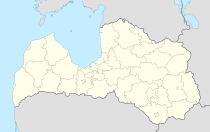Skrunda
| Skrunda | ||
|---|---|---|
 |
|
|
| Basic data | ||
| State : |
|
|
| Landscape: | Courland ( Latvian : Kurzeme ) | |
| Administrative district : | Skrundas novads | |
| Coordinates : | 56 ° 41 ' N , 22 ° 1' E | |
| Residents : | 2,236 (Jan 1, 2016) | |
| Area : | 7.9 km² | |
| Population density : | 283 inhabitants per km² | |
| Height : | 50 m | |
| City law: | since 1996 | |
| Website: | www.skrunda.lv | |
| Post Code: | ||
| ISO code: | ||
Skrunda (German Schrunden ) is a small town in Kurzeme , Latvia on the banks of the Venta . It is located on the road from Liepāja to Saldus south of Kuldīga . In 2016 it had 2236 inhabitants.
history
The area was populated by cures . Skrunda was first mentioned in a document in 1253. In 1368 the Livonian branch of the Teutonic Order built a castle here. In the 17th century the place flourished as part of the Duchy of Courland and Zemgale . There were factories for glass as well as for metal goods and military equipment. In the Great Northern War (1700-1721) the castle was destroyed and not rebuilt. At the time of the Russian Empire , a crown property was established, the manor house can still be visited.
After the First World War , the 2nd Latvian Rifle Regiment entered the city on January 22nd. These Latvian riflemen were driven out a week later in a larger battle by the also Latvian Kolpak Battalion, which fought with the Germans as part of the Baltic State Armed Forces .
The city developed after parts of the former manor land were released for building. In 1929 the Glūda - Liepaja railway line was opened. In 1935 there were more than 50 small businesses and some industrial companies.
During the Second World War , the city was in the front line in 1944 and 1945. After the Red Army conquered Skrunda , the Soviet occupiers began to deport Latvian citizens to Siberia . On one day alone, March 25, 1949, 228 residents were abducted. At the train station, a cattle wagon serves as a memorial to the deported residents.
From 1950 to 1959 Skrunda was the district town. There was a large peat factory and other industries here.
In 1996 Skrunda was the last Latvian place to be granted city rights.
The former Soviet military base Skrunda-1 is located near the city. After the Soviet armed forces withdrew in October 1999, their systems were sold to a Russian investor.
In 2015 the municipality of Skrunda bought the site back.
Personalities
- Karl Eduard Eichwald worked as a doctor in Skrunda from 1819 to 1821, before becoming known as a paleontologist.
Town twinning
Skrunda has twinned cities with Põltsamaa (Estonia) and cities in France, China and Georgia.
literature
- Hans Feldmann , Heinz von zur Mühlen (ed.): Baltic historical local dictionary, part 2: Latvia (southern Livonia and Courland). Böhlau, Cologne 1990, ISBN 3-412-06889-6 , pp. 563-564.
- Astrīda Iltnere (ed.): Latvijas Pagasti, Enciklopēdija. Preses Nams, Riga 2002, ISBN 9984-00-436-8 .
Web links
- Latvia e-guide (English)
Individual evidence
- ↑ «Latvijas iedzīvotāju skaits pašvaldībās pagastu dalījumā"
- ↑ a b c d e Hans Feldmann, Heinz von zur Mühlen (ed.): Baltic historical local lexicon, part 2: Latvia (southern Livland and Courland). Böhlau, Cologne 1990, ISBN 3-412-06889-6 , p. 563.
- ↑ For sale military base . In: Neue Zürcher Zeitung , February 6, 2010, viewed on June 15, 2013.
- ↑ Russians bid for a ghost town in Latvia . In: Die Welt , February 10, 2010, viewed on July 9, 2015.
- ↑ House war instead of musical In: Süddeutsche Zeitung , August 9, 2016, accessed on August 6, 2017
